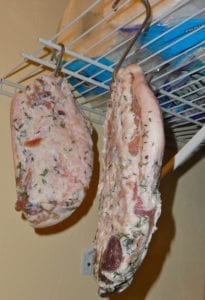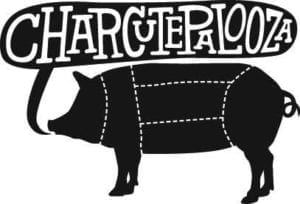 The #Charcutepalooza challenge for February is The Salt Cure. The main challenge was Pancetta or Guanciale or Bacon. However, other salt cures like, preserved lemons, are acceptable too. I first tried guanciale last year when a friend got ahold of some very inexpensive jowls from Prather Ranch Meat Company at the farmer’s market. He cured it into guanciale and gave us some. We had two delicious pastas with it. I’ve been swearing I’d make it myself since then. I had not gotten around to it yet. I’ve also long been a fan of pancetta, but don’t buy it often because of it’s price. Feeling like being a little adventurous I made both for the challenge.
The #Charcutepalooza challenge for February is The Salt Cure. The main challenge was Pancetta or Guanciale or Bacon. However, other salt cures like, preserved lemons, are acceptable too. I first tried guanciale last year when a friend got ahold of some very inexpensive jowls from Prather Ranch Meat Company at the farmer’s market. He cured it into guanciale and gave us some. We had two delicious pastas with it. I’ve been swearing I’d make it myself since then. I had not gotten around to it yet. I’ve also long been a fan of pancetta, but don’t buy it often because of it’s price. Feeling like being a little adventurous I made both for the challenge.
The pancetta takes longer, so I started with that. It starts off with a pork belly, just like all bacons. Pancetta is just an unsmoked bacon that is rolled after curing. The belly I used even had one nipple on it. It reminded me that this was pig not long ago. You can see it in the picture to the right. The skin was removed it and then it was rubbed all over with the cure. The cure has more spices than bacon, like nutmeg, juniper berries, bay leaves and there’s garlic in there too. I sealed it up
Pancetta is just an unsmoked bacon that is rolled after curing. The belly I used even had one nipple on it. It reminded me that this was pig not long ago. You can see it in the picture to the right. The skin was removed it and then it was rubbed all over with the cure. The cure has more spices than bacon, like nutmeg, juniper berries, bay leaves and there’s garlic in there too. I sealed it up 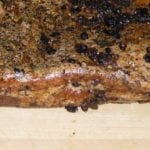 with the FoodSaver, but didn’t vacuum out all the air. I thought that I’d like to be able to move the cure around a little. Each day for 8 days I turned it and massaged it a little to re-distribute the cure. After 8 days it was firmer and the color had changed a bit. It smelled great when I took it out of the bag.
with the FoodSaver, but didn’t vacuum out all the air. I thought that I’d like to be able to move the cure around a little. Each day for 8 days I turned it and massaged it a little to re-distribute the cure. After 8 days it was firmer and the color had changed a bit. It smelled great when I took it out of the bag.
After washing the spices off and dr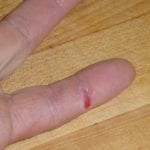 ying the belly is rolled up into what was now looking like pancetta. The book is very specific about tying it up at this point. You want absolutely no air pockets in the middle for bacteria to grow in. You can’t tie it too tight. I may have gone a little overboard as I got this deep blister on my left pinkie. I used a lot of string to tie it up. The ends bulged a little from my tying too.
ying the belly is rolled up into what was now looking like pancetta. The book is very specific about tying it up at this point. You want absolutely no air pockets in the middle for bacteria to grow in. You can’t tie it too tight. I may have gone a little overboard as I got this deep blister on my left pinkie. I used a lot of string to tie it up. The ends bulged a little from my tying too.
The pancetta hung in the garage for a day or two, but the humidity wasn’t high enough and we were, and still are, having unseasonably warm weather. Into the mini fridge it went. I hooked up my Ranco ETC controller to keep the temperature at 55°F. I didn’t need to do much with the humidity as the fridge defrosted often enough to keep the humidity up in the right range most of the time.
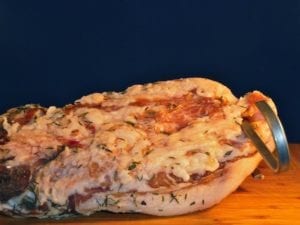 By now the pork jowls I had ordered from Marin Sun Farms had come in. Time to make guanciale. Except for the rolling, the process is much the same. The cure is a little different too. So the jowls went into a bag with their cure and in the fridge to hang out a few days. After 6 days the were firm and ready to be hung. I’m not sure why, but this recipe calls for hanging in a cool, dry place as opposed to the cool, humid place the pancetta was to hang. The garage was staying cool enough I thought and I hung them there by making a hole in one corner and using extra pot rack hooks to hang them by.
By now the pork jowls I had ordered from Marin Sun Farms had come in. Time to make guanciale. Except for the rolling, the process is much the same. The cure is a little different too. So the jowls went into a bag with their cure and in the fridge to hang out a few days. After 6 days the were firm and ready to be hung. I’m not sure why, but this recipe calls for hanging in a cool, dry place as opposed to the cool, humid place the pancetta was to hang. The garage was staying cool enough I thought and I hung them there by making a hole in one corner and using extra pot rack hooks to hang them by.
They hung there for 8 days and seemed to qualify as completely stiff, but not hard as the recipe notes. After cutting I noticed that maybe it could have dried a little longer, but I don’t think it will make a significant difference.
So, what to do with all this luscious cured meat? Spaghetti or bucatini all’amatriciana or Spaghetti alla Carbonara springs to most people’s mind. They can be made with either guanciale or pancetta. Both are wonderful, but if you want to showcase the meat more, I prefer Mario Batali’s spaghetti or bucatini alla Gricia.
Bucatini alla Gricia The way I make it for the two of us:
1 Tablespoon Extra-Virgin Olive Oil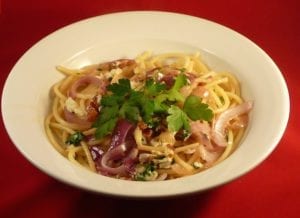
1/2 teaspoon red pepper flakes
(more or less to taste)
3-4 oz guanciale or pancetta diced
1 small red onion or half a large one
1 large clove of garlic sliced
6 oz bucatini or spaghetti
1/4 cup pecorino romano or parmesan
2 Tablespoons chopped fresh parsley
Boil salted water for the pasta. Put bowls or plates into a 200°F oven to warm. Mine fit nicely in the toaster oven.
Heat olive oil in a pan over medium low heat. Add red pepper flakes and guanciale or pancetta. Cook until the meat has rendered the fat and is crisp. Add the onion and garlic and cook until the onion browns. Turn heat to very low or off. Do not drain off the lucious fat.
Cook the pasta until al dente.
Turn heat up in the sauté pan and add the drained pasta. Toss to distribute everything and then add the cheese and half the parsley, tossing again. Divvy it up between two pasta bowl or plates. Garnish with remaining parsley and optionally with a little more cheese.
Note: I use only 3 oz of pasta per person. That seems to be plenty for us. Most recipes use 4 ounces per person, adjust as you see fit. I love bucatini for it’s texture here, but it can be a little difficult to find.
Recipes for both Pancetta & Guanciale in:Charcuterie: The Craft of Salting, Smoking, and Curing By Michael Ruhlman & Brian Polcyn.
| These comments are from the previous commenting system.MARDI@EATLIVETRAVELWRITE Hey Scott – nice post – your pancetta is absolutely gorgeous! I heartily approve of your choices of recipes for using the pancetta in – my list looks very similar! LOVE bucatini 🙂 Tuesday, February 8, 2011 – 03:49 AMMOSAICA Hi Scott,It’s beautiful & encouraging to see how nicely your cured meats have turned out. Boy, the pancetta is just so handsome! Reading your post helps me pass the time ’til mine is finished :-)Cheers! Tuesday, February 8, 2011 – 03:26 PMFOONGFEST Wow, those are some really lovely looking pancetta. Fantastic! Wednesday, February 9, 2011 – 09:41 AM |
